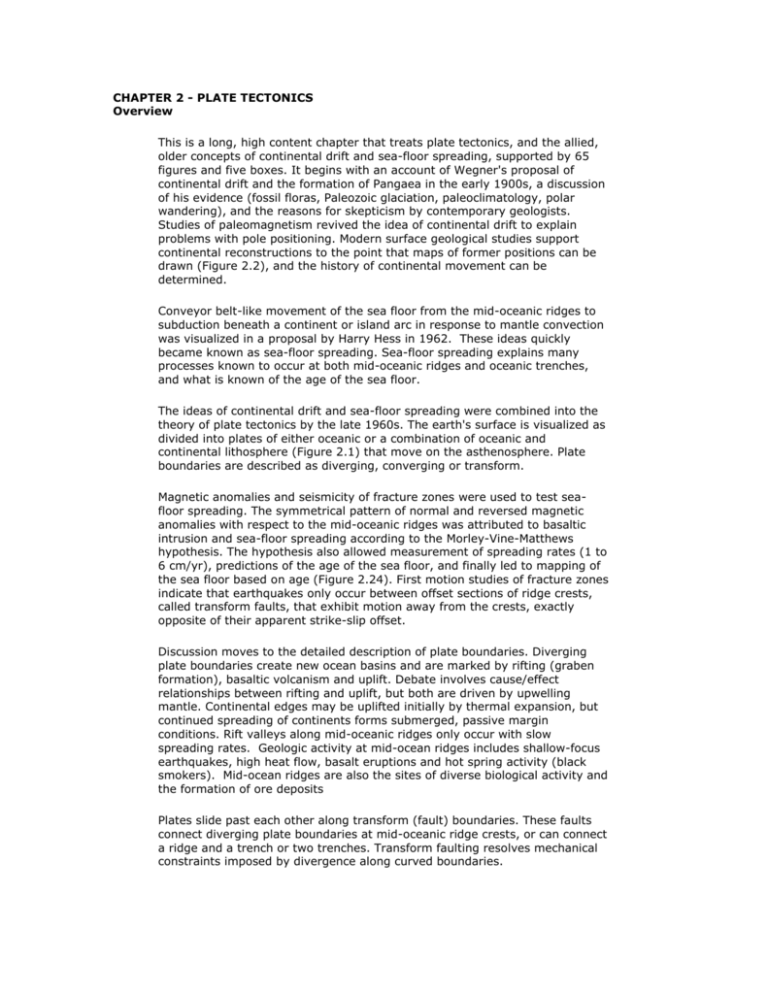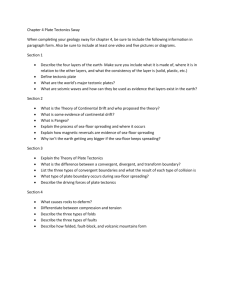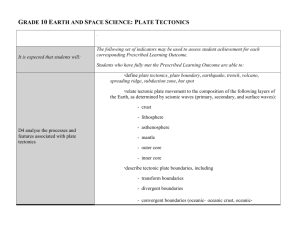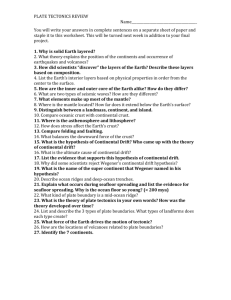CHAPTER 19 - PLATE TECTONICS
advertisement

CHAPTER 2 - PLATE TECTONICS Overview This is a long, high content chapter that treats plate tectonics, and the allied, older concepts of continental drift and sea-floor spreading, supported by 65 figures and five boxes. It begins with an account of Wegner's proposal of continental drift and the formation of Pangaea in the early 1900s, a discussion of his evidence (fossil floras, Paleozoic glaciation, paleoclimatology, polar wandering), and the reasons for skepticism by contemporary geologists. Studies of paleomagnetism revived the idea of continental drift to explain problems with pole positioning. Modern surface geological studies support continental reconstructions to the point that maps of former positions can be drawn (Figure 2.2), and the history of continental movement can be determined. Conveyor belt-like movement of the sea floor from the mid-oceanic ridges to subduction beneath a continent or island arc in response to mantle convection was visualized in a proposal by Harry Hess in 1962. These ideas quickly became known as sea-floor spreading. Sea-floor spreading explains many processes known to occur at both mid-oceanic ridges and oceanic trenches, and what is known of the age of the sea floor. The ideas of continental drift and sea-floor spreading were combined into the theory of plate tectonics by the late 1960s. The earth's surface is visualized as divided into plates of either oceanic or a combination of oceanic and continental lithosphere (Figure 2.1) that move on the asthenosphere. Plate boundaries are described as diverging, converging or transform. Magnetic anomalies and seismicity of fracture zones were used to test seafloor spreading. The symmetrical pattern of normal and reversed magnetic anomalies with respect to the mid-oceanic ridges was attributed to basaltic intrusion and sea-floor spreading according to the Morley-Vine-Matthews hypothesis. The hypothesis also allowed measurement of spreading rates (1 to 6 cm/yr), predictions of the age of the sea floor, and finally led to mapping of the sea floor based on age (Figure 2.24). First motion studies of fracture zones indicate that earthquakes only occur between offset sections of ridge crests, called transform faults, that exhibit motion away from the crests, exactly opposite of their apparent strike-slip offset. Discussion moves to the detailed description of plate boundaries. Diverging plate boundaries create new ocean basins and are marked by rifting (graben formation), basaltic volcanism and uplift. Debate involves cause/effect relationships between rifting and uplift, but both are driven by upwelling mantle. Continental edges may be uplifted initially by thermal expansion, but continued spreading of continents forms submerged, passive margin conditions. Rift valleys along mid-oceanic ridges only occur with slow spreading rates. Geologic activity at mid-ocean ridges includes shallow-focus earthquakes, high heat flow, basalt eruptions and hot spring activity (black smokers). Mid-ocean ridges are also the sites of diverse biological activity and the formation of ore deposits Plates slide past each other along transform (fault) boundaries. These faults connect diverging plate boundaries at mid-oceanic ridge crests, or can connect a ridge and a trench or two trenches. Transform faulting resolves mechanical constraints imposed by divergence along curved boundaries. Converging plate boundaries involve three relationships: ocean-ocean, oceancontinent, and continent-continent convergence. Ocean-ocean convergence subducts one plate, develops a Benioff zone, a trench and an andesitic to basaltic island arc. Distance between the island arc and trench vary depending on where the subducting plate reaches the 100 km depth where magma is generated. Ocean-continent convergence subducts the oceanic plate beneath the continental plate, and develops a Benioff zone, trench, andesitic magmatic arc, and young mountain belt. Continent-continent convergence resembles ocean-continent convergence in its early stages, but since continental crust cannot be subducted, a suture zone mountain belt marks the former subduction zone. Backarc spreading may accompany convergence involving continents. Ore deposits are also commonly associated with convergent plate boundaries. Plate convergence causes intense deformation and uplift of rocks creating mountain belts in a process called orogenesis. Orogenies may occur as a result of arc-continent convergence or continent-continent convergence. Brief discussion of migrating plate boundaries, plate size, and a summary of those geologic features and processes explained by plate tectonics precedes a detailed discussion of the causes of plate motions. Mantle convection is probably the result of plate motions rather than the cause of them. Plate motions are explained by three models, each of which probably makes a contribution: ridge-push, slab-pull, trench-suction. Recent studies of seismic tomography suggest cold (old) lithosphere may subduct to the core-mantle boundary, while warm (young) lithosphere may only reach the 670 km boundary. There appears to be little mixing within the mantle and convection is probably confined to mantle plumes forming hot spots, aseismic ridges, and possibly the beginning of plate divergence. The chapter ends by relating plate tectonics to our everyday lives, particularly to the prediction of earthquake occurrence and resource exploration Learning Objectives 1. Continental drift was proposed by Alfred Wegner in the early 1900s based on the apparent fit of continental coastlines, similar fossil plants and animals on widely separated continents, distribution of Paleozoic glaciations and paleoclimatology, and apparent polar wandering. 2. Wegner proposed that all continents had once been connected in a supercontinent called Pangea, that broke apart to form the present continents. Wegner thought the continents moved across stationary oceanic crust from a combination of centrifugal and gravitational force. His ideas received little support when proposed. 3. Paleomagnetism is the study of the ancient magnetic fields of the earth. Magnetized minerals preserve a record of the direction of the magnetic pole and their distance from it at the time of their formation. Paleomagnetic data revived interest in continental drift by demonstrating polar wandering and supporting the reconstruction of Pangea. 4. Other recent evidence for continental drift includes better continental margin fits, similar rock contacts and age relations between continents when fitted together, glacial movements indicated by striations, and sources of boulders in ancient tills, and similar geologic sequences including metamorphic rocks in Brazil and Gabon. 5. The idea that the sea floor spread away from mid-oceanic ridges and was subducted beneath a continent or island arc as a result of mantle convection was proposed by Harry Hess in the early 1960s. 6. Sea-floor spreading explains processes at the mid-oceanic ridges as the result of rising mantle: the existence of the ridge itself, high heat flow, basaltic volcanism, a rift valley and shallow-focus earthquakes. 7. Sea-floor spreading explains processes at the oceanic trenches as the result of descending oceanic crust: existence of the trench itself, low heat flow, negative gravity anomalies, Benioff zones, and andesitic volcanism. 8. Sea-floor spreading explains the young age of the sea floor, loss of older oceanic crust, lack of pelagic sediment on the ridge crest, and increasingly older oceanic crust away from the ridge crest. 9. Plate tectonics is the theory that the earth's surface is divided into a few large, thick plates that move and change size. It combines the older ideas of continental drift and sea-floor spreading. Plates are formed by lithosphere (crust and uppermost mantle) and move on the asthenosphere to a depth of about 200 km. New lithosphere is added along the ridges at the trailing edge of the plate and lost to subduction. Plate boundaries are either diverging, converging or transform. 10. The Morley-Vine-Matthews hypothesis recognized that sea floor magnetic anomalies were symmetrical with respect to the mid-oceanic ridge crests and matched the pattern of magnetic reversals discovered previously in stacked lava flows. The hypothesis also accounted for the patterns by magnetization of basaltic dikes intruded into the ridge crests, split and moved away from the ridges. Based on the Morley-Vine-Matthews hypothesis, spreading rates are 1 to 6 cm/year. The hypothesis also allows prediction of the sea floor age based on magnetic anomalies that can be tested with samples recovered by deep-sea drilling. 11. Other tests of plate tectonics involve recognition that fractures off-setting mid-oceanic ridges are transform faults, that have earthquakes confined to the segments between ridge crests and first-motions opposite those predicted if the fractures were simple strike-slip faults. 12. Diverging plate boundaries experience extension that produces normal faults, shallow-focus earthquakes, rift valleys (grabens), basaltic volcanism, crust thinning, uplift, and creates new ocean basins. Whether rifting causes uplift, or vice versa is unclear. Thick accumulations of salt may mark initial flooding of the rift valley, bordered by uplifted and exposed continental margins. Later stages of diverging boundaries produce passive continental margins. Metallic ore bodies and exotic life forms may be associated with diverging plate boundaries because of hot spring activity. 13. Transform boundaries allow plates to slide past one another. These boundaries exhibit strike-slip motion and may connect two ridge segments, a ridge and a trench, or two trenches. The straight course of these faults resolves mechanical constraints caused by divergence along curved boundaries, and are always aligned parallel to the spreading direction. 14. Ocean-ocean convergence is characterized by andesitic to basaltic island arcs, Benioff zones, low heat flow, accretionary wedges, and forearc basins. The descending plate must reach 100 km to begin generating magma. The position of the trench and the hingeline of bending migrate seaward progressively onto the subducting plate. 15. Ocean-continent convergence exhibits an active continental margin, accretionary wedge, forearc basin, Benioff zone, and a magmatic arc associated with young mountain belts. A foreland basin may also be formed in response to the weight of the thrust sheets forming the mountain belt. 16. Continent-continent convergence passes through the stages exhibited by ocean-continent convergence, but results in a suture zone of young mountains in continental interiors marking the former subduction site, thickened continental crust, and shallow focus earthquakes. 17. Backarc spreading can move the position of an island arc or a small strip of continental crust. Sea floor formed by backarc spreading is apparently that found as ophiolites. Ridge crests, trenches, transform faults, and their associated features are capable of migration in response to changing mantle conditions. Plate size increases or decreases in response to spreading and subduction. 18. Ore deposits are also commonly associated with convergent plate boundaries where metal-rich ophiolites have been brought to the surface, or ore-bearing magmas form island arcs or intrude continental crust. 19. Plate convergence causes intense deformation and uplift of rocks creating mountain belts. Mountain building events (orogenies) may occur as a result of arc-continent convergence or continent-continent convergence. 20. Mantle convection may be the result of plate motion, not the cause of it. Plate motion is caused by one, or a combination of the following three mechanisms: 1) ridge-push - sea floor and lithosphere slides down the slope of the lithosphere-asthenosphere boundary; 2) slab-pull - cold, sinking lithosphere being subducted pulls the plate away from the ridge crest; 3) trench-suction - horizontal pull of trench as it moves seaward from steeply subducting plate. Slab-pull accounts for most plate movement, and all rapid plate motion. 21. Mantle convection may result in mantle plumes. They are stationary with respect to moving plates and produce hot spots, such as Yellowstone, Iceland and the Hawaiian Islands. Mantle plumes may also be responsible for the initial fracturing of the lithosphere in a characteristic three-pronged pattern that begins divergence (e.g. Red Sea region). Aseismic ridges connect seamounts and guyots that may reflect plate passage over a hot spot. 22. Plate tectonics explains: distribution of basaltic and andesitic volcanoes, shallow-, intermediate-, and deep-focus earthquakes (Benioff zones), young mountain belts, mid-oceanic ridges, oceanic trenches, and fracture zones. Reconstruction of past plate movements is also required for resource exploration purposes. Boxes 2.1 – IN GREATER DEPTH – OCEANIC CRUST AND OPHIOLITES – Ocean crust is up to 7 km thick and consists of three layers. The top layer is marine sediment which is relatively thick close to continental margins and thins over mid-ocean ridges. This is underlain by Layer 2 which consists of pillow basalt and basalt dikes formed in the mid ocean ridge rift valley. The lowest layer, Layer 3 is intruded igneous rock such as gabbro. No-one has yet drilled into this lower layer on the sea floor. Ophiolites are distinctive rock sequences found in many mountain chains on land that consist of marine sedimentary rock underlain by pillow basalt, sheeted dikes and gabbro. These sequences are very similar to modern oceanic crust. 2.2 - IN GREATER DEPTH – THE WILSON CYCLE – The Wilson Cycle was proposed by Canadian geophysicist J.Tuzo Wilson to explain the cyclic opening and closing of ocean basins. He identified six stages of the cycle beginning with the fracturing of a craton over a mantle hot spot to create a rift valley. Widening of the rift valley and formation of basaltic ocean crust along the valley floor allows the development of a new ocean. Progressive widening of the ocean by addition of igneous mantle material along a mid-ocean ridge system continues until a subduction zone forms and ocean crust is consumed along deep ocean trenches. Eventually, the two continents that were originally separated collide and are sutured together again. This cycle of continental separation, ocean basin formation and closure has occurred repeatedly during the Phanerozoic. 2.3 – IN GREATER DEPTH - BRITISH COLUMBIA AND THE JUAN DE FUCA PLATE/CASCADIA SUBDUCTION ZONE – The Juan de Fuca plate is a small oceanic plate colliding at an oblique angle with the western seaboard of North America, along a zone known as the Cascadia Subduction Zone. Sediments are scraped off the descending plate and accreted to the North American landmass as an accretionary wedge. Magma generated from the subducting crust rises to the surface to form the volcanoes of the Cascade Mountains of British Columbia, Washington, Oregon and northern California. The subducting plate creates the potential for frequent large and damaging earthquakes along the B.C. and Washington coasts. 2.4 – IN GREATER DEPTH – THE GEOLOGICAL SIGNIFICANCE OF AULACOGENS – Aulacogens are rift valleys that formed during initial doming of a continent but failed to develop further. These ‘failed rifts’ are found on all continents and are of geological significance as sites of petroleum production and intraplate earthquake occurrence. The North Sea Basin and the Niger River valley are examples of globally-significant hydrocarbon producing regions that lie within aulacogens. The Ottawa-Bonnechere Graben and St. Lawrence Rift in southern Ontario are both examples of aulacogens that were reactivated during the break up of Pangea and are now associated with frequent earthquake activity. 2.5 - IN GREATER DEPTH - PLATE TECTONICS AND EARTHQUAKE RISK IN SOUTHERN ONTARIO – The Canadian Shield formed over a long time period by the accretion of many micro-continents. Boundaries between the amalgamated micro-continents are represented by suture zones which once formed the base of substantial mountain ranges. The mountains have been eroded away but the crust within suture zones is weakened by extensive fault systems and is commonly the site of earthquake activity. Southern Ontario is underlain by several suture zones in the Shield, one of which (the Central Metasedimentary Belt Boundary Zone) extends from northeastern Ontario into Pennsylvania and is associated with small magnitude intraplate earthquake activity. It has been calculated that a magnitude 7 earthquake could occur in southern Ontario once every 3,000 years. Short Discussion/Essay 1. What evidence has the Ocean Drilling Program (ODP) provided to support plate tectonics? 2. Briefly state the relationship of Plate Tectonics, Sea-floor Spreading and Continental Drift. 3. What is the difference between a mid-ocean ridge and a mantle plume? 4. Why were Benioff zones so difficult to explain prior to plate tectonics? 5. Why does subduction generally produce andesite and not basalt? Longer Discussion/Essay 1. What is the role of sea-floor spreading in producing the layering of the earth's crust and interior that exists today? 2. How can geologists be certain that plate tectonics occurred on the earth prior to the Jurassic Period? 3. In the 1940s, the membership of the American Association of Petroleum Geologists voted that the continents had never moved. Why did it take geologists so long to accept plate tectonics and continental drift? Why do some still deny it? 4. How can spreading rates vary, both through time and among the various mid-ocean ridges that cross the earth? 5. Why can't mantle convection drive plate tectonics? Selected Readings Plate tectonics is covered extensively in many textbooks on structural geology and petrology, and continues to be the subject of many popular articles for a general readership. A few interesting articles include: Allegre, C.J. and Schneider, S.H. 1994. "The evolution of the earth," Scientific American 271: 66-75. Dalziel, I.W.D. 1995. "Earth before Pangaea," Scientific American 272: 58-81. Eyles, N. 2002. Ontario Rocks. Fitzhenry and Whiteside, Toronto, 339pp. Connects plate tectonics theory with the evolution of the Province of Ontario. Hsu, K., 1992. Challenger at Sea: The Ship that Revolutionized Earth Science. Princeton University Press. 260pp. A history of the plate tectonic revolution as seen by a participant aboard the famous drill ship ‘Challenger’. Larson, R.L. 1995. "The Cretaceous superplumes episodes," Scientific American 272:82-86. MacDonald, K.C. and Fox, P.J. 1990. "The mid-oceanic ridge," Scientific American 262: 72-79. Menard, H.W., 1997. The Ocean of Truth. A Personal History of Global Tectonics. Princeton University Press. 353pp. Oreskes, N., 1999. The Rejection of Continental Drift. Oxford University Press. 250pp. An excellent account of Wegener’s theory of ‘continental drift’, its early rejection and its ultimate triumph as ‘plate tectonics’. Tunnicliffe, V. 1992. "Hydrothermal-vent communities of the deep sea," American Scientist 80(4): 336-349. White, R.S. and McKenzie, D.P. 1989. "Volcanism at rifts," Scientific American 261: 62-71. The Winter 1993/1994 issue of Oceanus (1994. 36(4), published by Woods Hole Oceanographic Institution) is devoted entirely to a review of the 25 year history of ocean drilling, and contains excellent articles on paleoceanography, the lithosphere, tectonics, sedimentary processes, and ODP history.








